The 5 Best Centrifugal Juicers, Tested and Dietitian-Approved
Dotdash Meredith and Yahoo Inc. may earn commission or revenue on some items through the links below.
For home juicing that rivals your favorite juice shop, consider one of these expert-tested favorites.
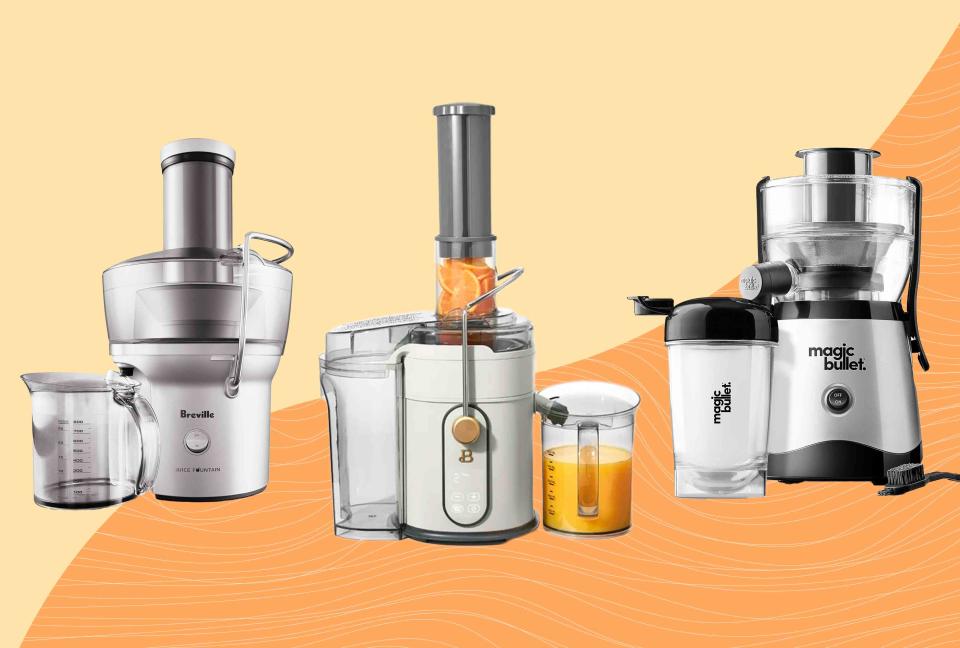
Courtesy of Brand
Juicing has come a long way from the era of juice fasts and cleanses, with the new perspective that it’s a great way to get more nutrients from fruit and vegetables into your diet without skipping meals. However, juices can be incredibly expensive—sometimes over and above $20 for just a few swigs—so many are bringing their juicing practice in-house by purchasing a juicer and liquefying their produce at home.
Two of the more commonplace types of machines you can find are the centrifugal juicer and the masticating juicer, each with its own unique method of extraction. In this roundup, we’re exploring the world of centrifugal juicers, a whopping 13 of which we put to the test in our Lab. We gauged the effectiveness of each juicer in tackling some of the most fibrous produce, then evaluated them for sound, ease of cleaning and more to arrive at our choices for the best centrifugal juicers.
Our Centrifugal Juicer Recommendations
Best Overall: Breville Juice Fountain Compact
Best Value: Beautiful by Drew Barrymore Electric Juice Extractor
Best Splurge: Breville the Juice Fountain Elite
Best Mini: Magic Bullet Mini Juicer with Cup
Best Set: Nutribullet Juicer Pro
What Is a Centrifugal Juicer, Exactly?
Juicers primarily come in one of two categories: masticating and centrifugal. According to dietitian Dana White, M.S., RD, ATC, these types of machines use very different mechanisms to extract juice from produce. “Masticating-style machines get their name from the gentler, crushing method they use to press ingredients for their juice.” Dietitian Cara Harbstreet, M.S., RD, LD, adds that masticating juicers give a “slightly higher fiber content with a thicker, more viscous texture.”
Centrifugal juicers, on the other hand, utilize a powerful spinning blade to pulverize produce. “The blades and other components inside a centrifugal juicer chop the fruits and veggies into a thick pulp,” says Harbstreet. “The pulp drops down into the barrel and spins extremely fast. The centrifugal force separates the liquid from other fibrous parts of the pulp, and the juice drains into a container through a spigot or spout at the bottom.”
Best Overall: Breville the Juice Fountain Compact
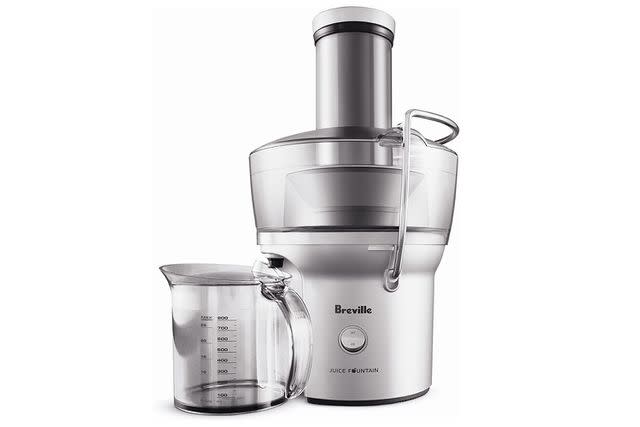
Amazon
What we like: This model may be compact in size, but it outperformed other larger and more costly options.
What to know: It may struggle with extremely fibrous ingredients like ginger, so consider pairing these with fruits and veggies with higher water content to extract the juice.
If you’re looking for a solid, high-performing juicer at an accessible price point, this model from Breville is definitely worth considering. Despite a slightly more compact body size than other similar machines, this Breville produces quality juice—not to mention less clogging than other models we tested.
This juicer has a sleek design with a simple, one-touch on-and-off switch, plus a 700-watt motor that packs a powerful punch. You won’t have to worry about messes with this Breville either, with its 25-ounce no-splash, covered juice jug, and plenty of space in the 1.6-quart pulp catch.
When we tested this juicer, it easily powered through our carrots and apples, giving us nearly twice as much juice as pulp. The mesh strainer did an excellent job separating the juice from the pulp, leaving us with smooth, velvety juices with bright flavors.
We did come across a small issue with this machine’s ability to process fibrous produce like ginger, and found that it spat out chunks at times rather than juice. Overall, though, this machine carries the quality we’ve come to expect with Breville appliances. It outperformed many others of higher cost and larger size, making this our favorite option among all those we tested.
Wattage: 700 watts | Dimensions: 9.1”D x 9.8”W x 15.7”H | Warranty: 1-year limited

EatingWell / Russell Kilgore
Best Value: Beautiful by Drew Barrymore Electric Juice Extractor
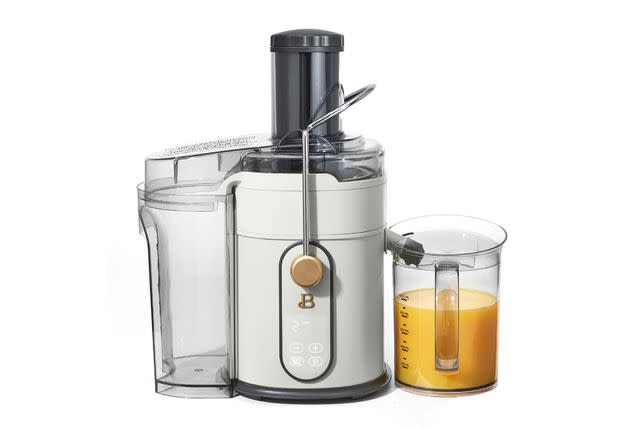
Walmart
What we like: We’re always fans of options, and this juicer has five settings available to help you blast through all types of produce.
What to know: Take care with low-water-content, high-fiber produce, as it can create some backups.
This juicer from the Beautiful by Drew Barrymore line is a great option for those on a budget—or who are simply not looking to spend an arm and a leg on a kitchen appliance. It comes in at under $100 and offers a lot in return for that investment.
With five speeds to tackle soft produce, leafy greens and citrus (peeled, of course), as well as ingredients with medium and hard textures, there’s a setting for practically anything you could throw at this machine. We’re also fans of the chic, matte colorways, which can make it feel like less of a blow to the aesthetic if this remains a countertop feature. As far as ease of use, this juicer ticks all the boxes with detachable, dishwasher-safe parts and a complimentary cleaning brush.
During our tests, this machine handled carrots, apples and leafy greens with ease. However, it struggled a little with the all-too-fibrous ginger. That said, the pulp extracted from each process felt quite dry, meaning a lot of juice was squeezed out of the ingredients. We also appreciated the larger size of the 70-oz. pulp collector and 1-liter juice jug for capturing the end product.
Wattage: 1,000 watts | Dimensions: 16.45”D x 8.42”W x 15.86”H | Warranty: 2 years
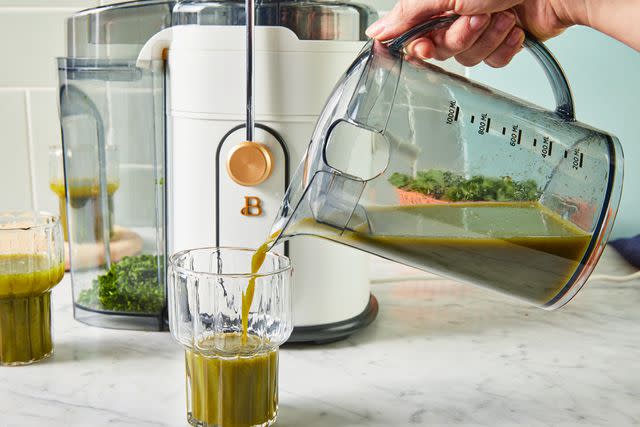
EatingWell / Will Dickey
Best Splurge: Breville the Juice Fountain Elite
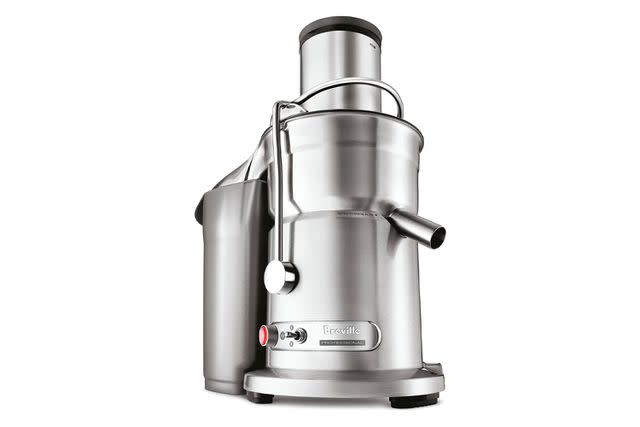
Amazon
What we like: If you’re looking for a high-speed juicer with impressive volume, this model is worth the spend.
What to know: While the added size is a plus, it can make for crowded cabinets and countertops.
If you’ve got the coins to spare, we love this Breville the Juice Fountain Elite. It’s a pricier model for sure, but it’s worth the cost, in our opinion. While there are some areas where this juicer felt like a similar experience to other Brevilles we tried, this machine differs in a few key areas. The Juice Fountain Elite is similarly easy to take apart and clean and has a 3-inch chute like the other models. But we found it outpaced its brethren in both stature and speed.
This juicer features two speed settings: low (for softer ingredients) and high (for harder ingredients). Due to the speed, less effort is needed to feed your produce into the machine, but the included plunger is still useful when juicing at a lower speed. The bottom-heavy design ensures that this machine remains stable no matter how intense your juicing gets.
When we tested this Breville model, we found it was a high performer and produced a good volume of juice with a very slightly damp pulp (indicating that most of the juice was extracted). The carrot juice had a velvety mouthfeel that we enjoyed, and the apple juice had a pleasantly sweet-tart flavor.
One thing to note is that, given its size, this juicer may require substantial storage space. But if that’s not an issue for you, we think this juicer makes a great investment.
Wattage: 1,000 watts | Dimensions: 13.1”D x 12”W x 10.6”H | Warranty: 1 year
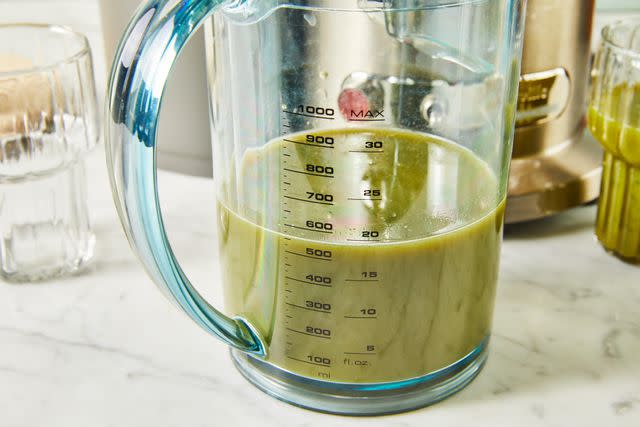
EatingWell / Will Dickey
Best Mini: Magic Bullet Mini Juicer with Cup
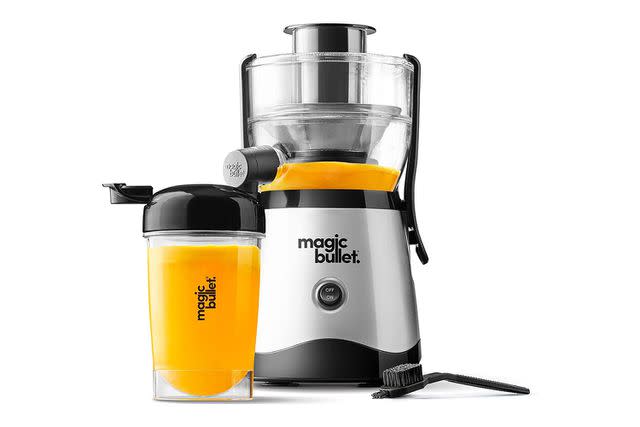
Amazon
What we like: Get high-quality juice for half the counter space with this small-but-mighty mini juicer.
What to know: This juicer is a bit noisy, and it struggled a bit when juicing our kale.
The old adage of “good things come in small packages” rings true when it comes to this Magic Bullet Mini Juicer. Despite its compact size, this machine has a relatively large capacity, with a 16-oz. tumbler and a whopping 52-oz. pulp bin. The tumbler also includes a lid for easy sipping so you can juice and run.
At nearly half the size of most other juicers we tested, the Magic Bullet Mini Juicer produces a decent-sized serving of juice without losing the quality or efficiency. We found this machine blitzed through chunks of ginger, one of the items that stumped other more powerful juicers and was incredibly easy to clean. Overall, we had some big wins with this little juicer.
In our testing, we found the simple on/off switch to be easy to manage, though additional higher speeds would have been nice to have. Additionally, while the instructions indicated that you could turn the juice spout upside down to stop the flow of juice, this shot juice vertically when we tried it, so we don’t recommend using that feature. Otherwise, nothing else was messy at all with this juicer.
Wattage: 400 watts | Dimensions: 7”D x 6”W x 11.5”H | Warranty: 1 year
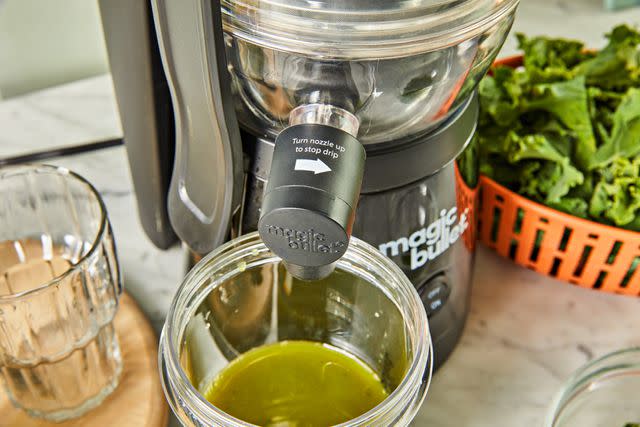
EatingWell / Will Dickey
Best Set: Nutribullet Juicer Pro
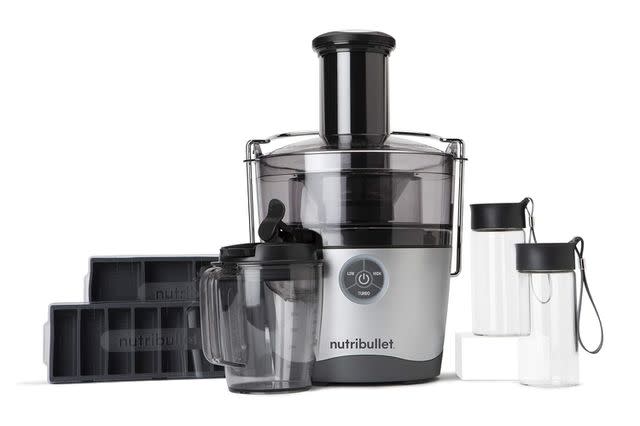
Amazon
What we like: We love the unique set of bells and whistles included with this set, including freezer trays so you can use your juicer to level up your smoothie game, too.
What to know: If easy cleaning is what you’re after, you might want to skip this juicer.
As far as juicers go, most are standalone products without practical accompaniments that enhance the user experience. However, the Nutribullet Juicer Pro not only serves as a high-powered, 3-speed juice dispenser but also includes an assortment of add-ons, including two travel-size glass containers and two sizes of freezing trays, which allow you to preserve your juices and add them to smoothies and other blended beverages—or even cook with them down the road.
In our testing, this model performed well with juicier fruit and vegetables and felt high-quality and durable. There were some issues with getting through tougher produce like ginger, and cleaning was more of a challenge given the bundt cake-shaped extractor feature, but all things considered, the juice is worth the squeeze (literally) with this set.
Wattage: 1,000 watts | Dimensions: 12.83”D x 12.13”W x 17.4”H | Warranty: 1 year
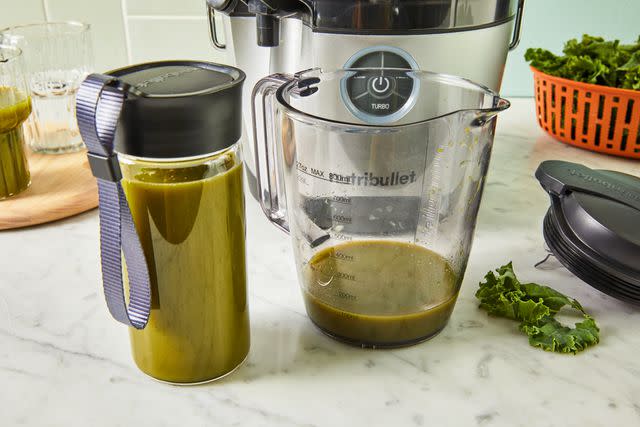
EatingWell / Will Dickey
The Bottom Line: The Best Centrifugal Juicers
The Breville the Juice Fountain Compact (view at Amazon) quite simply outpaced its peers with better overall extraction and speed—and it doesn’t come close to breaking the bank. This juicer is great for beginners and long-term juice drinkers alike and can tackle high-volume projects or just a daily craving for some extra nutrients. If you’re looking for a slightly more wallet-friendly option, we also love the Electric Juice Extractor from Drew Barrymore’s Beautiful line (view at Walmart).
Choosing a Centrifugal Juicer
Pick the Right Size
For most kitchens, a centrifugal juicer will be a larger appliance—think stand mixer size. For those with smaller kitchens or simply less space for new appliances, you may need to be especially mindful of space considerations for use and storage. If you do intend to dedicate precious square footage to a juicer, it may behoove you to find one indicated for more use or simply opt for one of the smaller models to get you started.
Performance Is Key
Nobody wants a juicer that’s going to jam up on them, or not be able to handle the load it’s intended for. If you tend to do a lot of high-volume juicing, make sure you’re getting a machine that’s powerful and fast enough to handle the job, or you could be standing there holding cucumbers all day long.
How Noisy Is It?
The juicers on our list are chosen for performance reasons, and while we love these machines, we know that even some of the best are quite loud. It’s worth considering the volume level you need to maintain at the time of day when you plan to juice, as some of these can surely wake up a household or even a neighbor.
Does It Produce Good Juice?
Most juices are bound to see some levels of oxidation or separation, and not all juicers are extracting the maximum quantity possible. Indicators of a quality machine are dry pulp and lower levels of oxidation and separation after a few hours of refrigeration.
Is It Easy to Clean?
Possibly the biggest hurdle to juicing, aside from the volume of produce you need to buy, is the cleanup. Some designs are easier to take apart, clean and reassemble than others. While you’re unlikely to find a machine that’s 100% dishwasher safe, you can opt for one with multiple parts that can be put in the dishwasher to keep your hand-washing to a minimum.
Is It a Good Value for the Price?
Just within our list, prices range dramatically from $60 to $300 for a machine, and while we believe all the ones we selected are quality, we also value ensuring that you get a bang for your buck. You don’t need to go all-out to get a solid appliance, so check in with factors like how much you spend on juice, how much you plan to use the machine and what additional features it offers before you splurge.
Our Centrifugal Juicer Tests
Each of our 13 carefully selected juicers underwent a battery of tests under observation from our kitchen experts to evaluate how well they can extract, the noise factor, ease of use, and other factors related to each juicer's versatility, value and quality. We juiced carrots, apples, kale, and ginger to gauge how well different fiber and water levels were tolerated and how quickly the juice was produced. Along with measuring the speed and efficiency of the machines, the final juice product was surveyed for any separation, oxidation and foaming. Finally, and possibly most importantly, our experts also weighed in on how easy these machines are to disassemble, clean and reassemble.
We Also Considered
Breville the Juice Fountain Plus ($180 at Amazon): We loved how easy this juicer was to assemble, use and clean, and we thought the materials seemed sturdy and durable. We also liked that the chute was large enough to accommodate whole produce. However, this Breville model didn’t do the best job juicing our kale or ginger, leaving us with more pulp than actual juice.
Kuvings Centrifugal Juicer ($150 at Amazon): This juicer was lightweight and easy to transport but struggled with more fibrous ingredients like kale and ginger. In fact, we had to stop and restart the machine multiple times when juicing our ginger due to the fibers getting caught in the blades. We recommend sticking to water-rich produce like apples with this machine.
Hamilton Beach Big Mouth Juice Extractor ($70 at Amazon): This machine powered through our apples and carrots easily, but when it came to the ginger, the motor struggled quite a bit—so much so that we could not finish juicing it. It’s also a bit cumbersome and noisy compared to other juicers we tested.
Mueller Ultra-Power Juicer ($40 at Amazon): This was one of the most budget-friendly juicers we tested, and we liked how easy it was to assemble and use. However, this one didn’t do well with our ginger and kale, and the materials felt cheap and flimsy.
Dash Compact Centrifugal Juicer ($100 at Amazon): With its slender design and wallet-friendly price point, this compact machine has a lot going for it. But as far as performance, it was simply outpaced by our other favorite mini option, the Magic Bullet Mini Juicer.
Common Questions
What’s the best way to clean a centrifugal juicer?
White recommends washing after every use and using a brush to remove tiny food particles from the inner mechanisms and filter baskets. "Many of the larger parts are dishwasher-safe. It’s also useful to start juicing with smaller, dryer and lower-yield ingredients first, then follow with higher water content ingredients to help flush the machine," White says. We also recommend checking the manufacturer's instructions before tackling your first cleaning session just to be sure you know how to disassemble, appropriately clean and reassemble your machine.
Do centrifugal juicers destroy the nutrients in fruits and vegetables?
According to Harbstreet, centrifugal juicers don’t necessarily destroy the nutrients—but they potentially can. “The high-speed spinning can generate some heat, which may denature some enzymes or proteins in fresh juice,” Harbstreet says. “And less fiber makes its way into the finished juice.”
White has similar feedback. “Centrifugal styles produce more heat, and it is sometimes speculated this can degrade nutrients and change the flavor of some juices,” she says. “But I believe these are fairly negligible.” Ultimately, these juicers can deliver the nutrients, though you won’t see much fiber content.
Is there anything you can’t put into a centrifugal juicer?
We always recommend reading the manufacturer’s instructions for what you can and cannot put into your juicer. Some are tested and approved for multiple uses, such as producing nut milk, and others are not. Common items to ensure you leave out of your juicing are large seeds, pits and certain peels like those from citrus.
Our Trusted Expertise
Tori Martinet is a Registered Dietitian with a Master of Science in Nutrition & Exercise Physiology from Columbia University Teachers College. She has a background in culinary nutrition, including developing juice and smoothie recipes for luxury fitness spaces throughout NYC. She is a freelance food and nutrition writer whose work has been featured in publications like Food & Wine, The Spruce Eats, Verywell Health, Verywell Fit, Health, Shape and more.
We also chatted with food and nutrition experts Dana White, M.S., RD, ATC, and Cara Harbstreet, M.S., RD, LD, to get their feedback on common questions related to all things juicing.
This article was edited by Kayleigh Drake, a former full-time baker and current EatingWell commerce editor and contributor to publications such as Food & Wine, The Spruce Eats and Simply Recipes and was reviewed by Brierley Horton, M.S., RD, senior commerce editor, who has 15 years of experience reporting, writing and editing nutrition and health content.
Read the original article on Eating Well.

